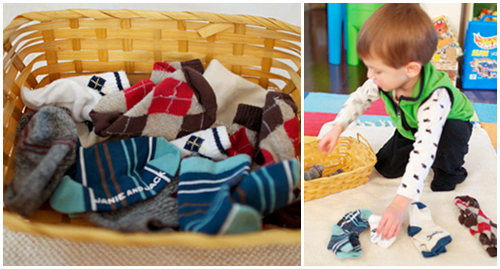Maria Montessori (1870-1952) noticed that young children are naturally drawn to the types of things that allow them to put their sense of order to use. They also have an inner developmental need to gain independence. This certainly seems to be true for most toddlers that I know.
A primary goal of Montessori philosophy is: "Help me to do it myself". We want to encourage children to learn by doing and to incorporate a sense of learning and accomplishment into their everyday tasks and activities. These little guys and gals are so much more capable than we realize!
Many Montessori-inspired activities promote self-sufficiency, have a built-in control of error, appeal to the senses, and/or prepare the finger muscles for holding a pencil for writing. Most importantly, they are geared towards a young child's developmental interests.
In order for us to successfully prepare the environment for learning, it is important that we regularly observe each child for changes in their particular interests and their developmental readiness.
Here are some of my previous posts on Montessori activities for younger children:
Throughout the past months, I have continued to introduce R to new Montessori-inspired works and he absolutely loves them. When I set up these activities, they are displayed in an organized and uncluttered way on low shelves that R can easily reach. Everything has a place in which it belongs and R is expected to return his work to the appropriate space. He chooses what he wants to do, and for how long.
Here are some of the activities that R has been working on throughout the past few months. (He is 2 years 4 months old). They are divided into the categories of: creating a sense of order, fine motor development, pre-literacy, math, sensorial, and practical life activities.
Matching Colors Creating a Sense of Order
Cars
Animals
Landmarks
Socks
Sorting
Shades of Color
Cereal
Shape Blocks
Silverware
Solid Figures (spheres, cylinders, and cubes)
Sequencing
Knobbed Cylinders (we bought the mini ones for now; they are more affordable)
Events from Books
Basic Skills Puzzle Cards
Fine Motor Development
Lacing
Shoe (this big shoe is easier for him to lace than his little shoes)
Animal Frames
Jumbo Beads (also used for learning simple patterns)
Paper Weaving
Pouring
Water (and wiping up the spills)
Juice
Spooning and Transferring
Stones
Erasers (could use for Valentine's Day)
Coins (could use for St. Patrick's Day)
Chicks (could use for Spring/Easter)
Beans
Cutting
Real Food (also spreading butter)
Wooden Food
Using Scissors
Pre-Literacy
Letter Matching
Alphabet Bean Bags (toss and act out something that begins with the phonetic sound)
Writing (if using the pen is too challenging, fill in the letter with play-doh)
Mathematics
Spindle Box
Sandpaper Numbers
Numbers and Counting Dots
Sensorial
Feely Bag
Sound Cylinders
Mixing Colors (to create new colors)
Bath Tub Jello (to dig for the hidden animals)
Sensory Tub
Practical Life
Self Care
Dressing Basket
Brushing Hair
Brushing Teeth
Putting on Shoes
Zipping, Snapping, and Buttoning
Washing Hands
Household Chores
Cleaning Windows
Washing Dishes
Sorting Laundry
Setting the Table
Arranging Flowers
Laying Out his Mat (and rolling it back up)
----------------------------------------------------------------------------------------------------------------------------------
Choosing a Montessori Pre-School
Here are some positive things that stood out to me about this school:
1. Teachers: Passionate about their students and about Montessori principles. I could already see R bonding with several of them when we were there at the open house.
2. Core Values: Each child is taught to develop their own unique personality instead of conforming to the social norms. A child does something because of an inner desire to do it, not because the teacher said so. The program highly values freedom, responsibility, curiosity, thinking outside the box, motivation, concentration, persistence, respect for all living things, manners, discipline, structure without limitations, and actively contributing to society.
3. Inherent Flexibility: The children go at their own paces and are never made to feel that they are "behind." The teacher adapts individualized lessons for each child, depending on their learning style, interests, and level of ability.
4. Classroom Community: The primary classroom consists of 3 to 6 year olds, which means that the older students act as teachers and mentors for the younger ones. They truly care about, admire, and support each another.
5. Everything is Child-Sized: bathrooms, sinks, the materials for children to prepare their own simple snacks, the clean-up supplies, the gardening tools. Each classroom as their own garden and they grow and eat their own vegetables. All of this really fosters a sense of independence and self-confidence.
6. Nature-based: Along with a playground, the children are also provided with an abundance of natural materials to explore during recess, such as sticks and logs to build their own forts. They go outside several times throughout the day to work directly with nature.


















































